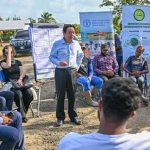Finance Minister Winston Jordan, during his presentation of the 2016 National Budget today, stated that $20.3B has been allocated to the agricultural sector to create an economic environment in which farming and agro-processing operations can grow the economy and create employment.
He restated the Government’s commitment to the promotion of agricultural diversification and restoring competitiveness in the traditional sectors. Additionally more than $598M will go towards agriculture expansion in the Rupununi savannahs, other hinterland areas and riverine communities.
Agricultural diversification and product transformation are high on the agenda for areas such as Bina Hill, Ebini, Manari and Hosororo. These are being examined for the establishment of several training, research and extension facilities. This will allow for the promotion of sustainable food production systems, thus maintaining the ecosystem. Additionally, it will concrete the ability to adapt to drought, flooding, climate change among many other disasters.
The government’s vision for the agricultural sector by 2020 is to promote it as an entrepreneurial enterprise and a wealth generator. Promotion of aquaculture and food processing among other initiatives will materialise, the Minister said.
Traditionally in Guyana, the production of rice and sugar has been economically lucrative and the sectors also employ many Guyanese, however high production costs, old machinery and weakening sugar prices on the world market are threatening the sugar industry, Minister Jordan stated. The 2016 Budget has proposed an allocation of $9B to assist the sugar industry’s modernisation and recovery programme. The government is committed to supporting this industry to become competitive and thus attract new trading partners, as the Venezuelan rice market is no longer available.
Pasteurisation plant
In the category of the livestock production, the development of a milk pasteurisation plant is intended to revitalise the cattle industry. In Region 9, there are 4,000 acres of state lands that are earmarked to build an agriculture trial station and is intended to facilitate sustainable harvesting of surface water for agriculture.
The land will be used for cattle rearing along with small ruminants; planting of vegetables and rice and aquaculture. The subsector will be invigorated with maximising the emphasis on animal health which will deal with emerging and known diseases.
The sector will also produce food and non- food commodities which will satisfy the needs of Guyana and its international and regional partners. Additionally, government is committed to revitalising competition in the traditional agricultural sectors.





